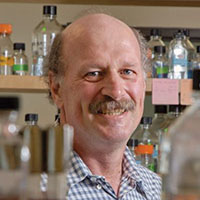When used in tandem, stem cells and gene editing make a powerful pair in the development of cell therapies for genetic diseases like sickle cell anemia and bubble baby disease. But the applications of these cutting-edge technologies go well beyond cell therapies.
This week, researchers at the Wellcome Trust Sanger Institute in the UK and the University of British Columbia (UBC) in Canada, report their use of induced pluripotent stem cells (iPSCs) and the CRISPR gene editing to better understand chlamydia, a very common sexually transmitted disease. And in the process, the researchers gained insights for developing new drug treatments.

Human macrophage, a type of white blood cell, interacting with a Chlamydia trachomatis bacteria cell. Image: Sanger Institute / Genome Research Limited
Chlamydia is caused by infection with the bacteria Chlamydia trachomatis. According to the Centers for Disease Control (CDC), there were over 1.5 million cases of Chlamydia reported in the U.S. in 2015. And there are thought to be almost 3 million new cases each year. Men with Chlamydia usually do not face many health issues. Women, on the other hand, can suffer serious health complications like pelvic inflammatory disease and infertility.
Although it’s easily treatable with antibiotics, the disease often goes unnoticed because infected people may not show symptoms. And because of the rising fear of antibiotic-resistant bacteria, there’s a need to develop new types of drugs to treat Chlamydia.
To tackle this challenge, the research teams focused first on better understanding how the bacteria infects the human immune system. As first author Dr. Amy Yeung from the Wellcome Trust Sanger Institute explained in a press release, researchers knew they were up against difficult to treat foe:
Amy Yeung
“Chlamydia is tricky to study because it can permeate and hide in macrophages [a type of white blood cell] where it is difficult to reach with antibiotics. Inside the macrophage, one or two chlamydia cells can replicate into hundreds in just a day or two, before bursting out to spread the infection.”
In the study, published in Nature Communications, the teams chose to examine human macrophages derived from iPSCs. This decision had a few advantages over previous studies. Most Chlamydia studies up until this point had either used macrophages from mice, which don’t always accurately reflect what’s going on in the human immune system, or human macrophage cell lines, which have genetic abnormalities that allow them to divide indefinitely.
With these human iPSC-derived macrophages, the team then used CRISPR gene editing technology to systematically delete, or “knockout”, genes that may play a role in Chlamydia infection. Lead author Dr. Robert Hancock from UBC described the power of this approach:
Robert Hancock
“We can knock out specific genes in stem cells and look at how the gene editing influences the resulting macrophages and their interaction with chlamydia. We’re effectively sieving through the genome to find key players and can now easily see genes that weren’t previously thought to be involved in fighting the infection.”
In fact, they found two genes that appear to play an important role in Chlamydia infection. When they knocked out either the IRF5 or IL-10RA gene, the macrophages were much more vulnerable to infection. The team is now eager to examine these two genes as possible targets for novel Chlamyia drug treatments. But as Dr. Gordon Dougan –the senior author from the Sanger Institute – explains, these studies could be far-reaching:
Gordon Dougan
“This system can be extended to study other pathogens and advance our understanding of the interactions between human hosts and infections. We are starting to unravel the role our genetics play in battling infections, such as chlamydia, and these results could go towards designing more effective treatments in the future.”



Any information/research on IPF treatment…please
On Wed, Apr 26, 2017 at 11:22 AM, The Stem Cellar wrote:
> Todd Dubnicoff posted: “When used in tandem, stem cells and gene editing > make a powerful pair in the development of cell therapies for genetic > diseases like sickle cell anemia and bubble baby disease. But the > applications of these cutting-edge technologies go well beyond cell th” >
CIRM is funding early stage research into IPF. You can read more about one of these studies in this blog: https://blog.cirm.ca.gov/2016/11/23/failed-stem-cells-may-cause-deadly-lung-disease/